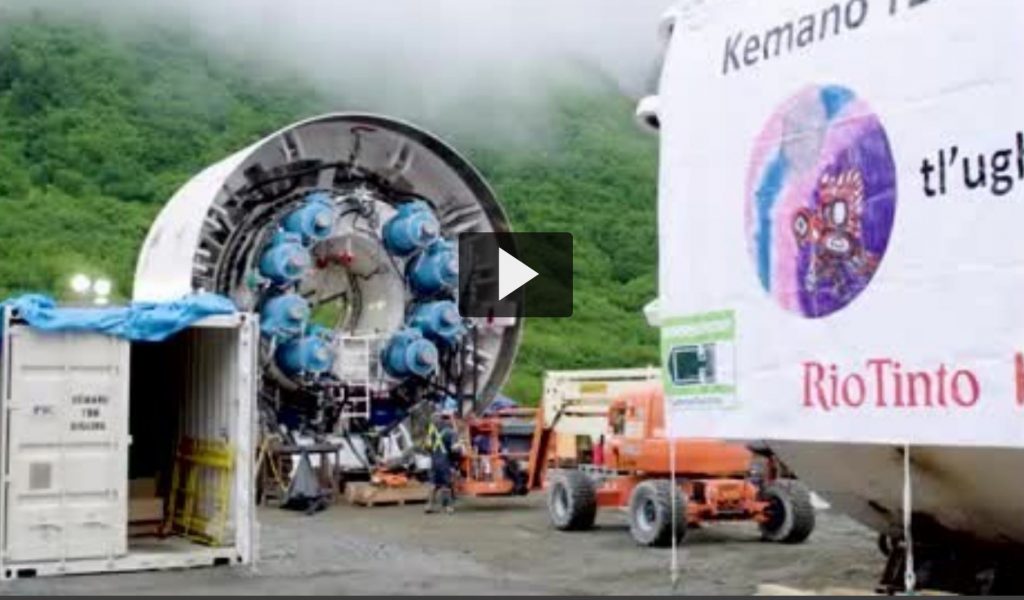[caption id="attachment_1003725267" align="aligncenter" width="469"]
 Named after a legendary snake, tl’ughus will soon be tunneling to boost clean energy for Rio Tinto’s aluminum smelter in British Columbia. (Image: Rio Tinto Aluminium)
Named after a legendary snake, tl’ughus will soon be tunneling to boost clean energy for Rio Tinto’s aluminum smelter in British Columbia. (Image: Rio Tinto Aluminium)[/caption]
BRITISH COLUMBIA –
Rio Tinto Aluminium, the
Cheslatta Carrier and the
Haisla First Nations launched the tl’ughus tunnel boring machine, a key milestone toward completing the Kemano second tunnel project. The 1,300-tonne machine will bore a 7.6-km tunnel as part of a $600 million project to enhance the long term electric power supply for the BC Works aluminum smelter in Kitimat.
The Cheslatta Carrier First Nation was given the honour of naming the borer, and they chose tl’ughus, a legendary giant snake. According to the legend, the mountains and landscape around the Nechako Reservoir were once home to this monster. It travelled from lake to lake by boring through the mountains. The openings created by the snake allowed fish to pass from lakes on one side of the mountain to lakes on the other side.
Students from the Haisla Community School took part in a contest to design the artwork that decorates tl’ughus. The winning design was created by grade six student Ali-Anna Wilson. Her work includes the raven, oolichan and Northern Lights.
Click here for more information on how Rio Tinto keeps a low carbon footprint in B.C.

 Named after a legendary snake, tl’ughus will soon be tunneling to boost clean energy for Rio Tinto’s aluminum smelter in British Columbia. (Image: Rio Tinto Aluminium)[/caption]
BRITISH COLUMBIA – Rio Tinto Aluminium, the Cheslatta Carrier and the Haisla First Nations launched the tl’ughus tunnel boring machine, a key milestone toward completing the Kemano second tunnel project. The 1,300-tonne machine will bore a 7.6-km tunnel as part of a $600 million project to enhance the long term electric power supply for the BC Works aluminum smelter in Kitimat.
The Cheslatta Carrier First Nation was given the honour of naming the borer, and they chose tl’ughus, a legendary giant snake. According to the legend, the mountains and landscape around the Nechako Reservoir were once home to this monster. It travelled from lake to lake by boring through the mountains. The openings created by the snake allowed fish to pass from lakes on one side of the mountain to lakes on the other side.
Students from the Haisla Community School took part in a contest to design the artwork that decorates tl’ughus. The winning design was created by grade six student Ali-Anna Wilson. Her work includes the raven, oolichan and Northern Lights.
Named after a legendary snake, tl’ughus will soon be tunneling to boost clean energy for Rio Tinto’s aluminum smelter in British Columbia. (Image: Rio Tinto Aluminium)[/caption]
BRITISH COLUMBIA – Rio Tinto Aluminium, the Cheslatta Carrier and the Haisla First Nations launched the tl’ughus tunnel boring machine, a key milestone toward completing the Kemano second tunnel project. The 1,300-tonne machine will bore a 7.6-km tunnel as part of a $600 million project to enhance the long term electric power supply for the BC Works aluminum smelter in Kitimat.
The Cheslatta Carrier First Nation was given the honour of naming the borer, and they chose tl’ughus, a legendary giant snake. According to the legend, the mountains and landscape around the Nechako Reservoir were once home to this monster. It travelled from lake to lake by boring through the mountains. The openings created by the snake allowed fish to pass from lakes on one side of the mountain to lakes on the other side.
Students from the Haisla Community School took part in a contest to design the artwork that decorates tl’ughus. The winning design was created by grade six student Ali-Anna Wilson. Her work includes the raven, oolichan and Northern Lights.





Comments